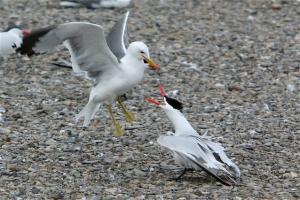forum
library
tutorial
contact

Steelhead-Munching Mid-Columbia Terns Fingered in Report
by Bill RudolphNW Fishletter, May 12, 2011
|
the film forum library tutorial contact |

|
Steelhead-Munching Mid-Columbia Terns Fingered in Report
by Bill RudolphNW Fishletter, May 12, 2011 |
 A draft report that has synthesized five years of research into avian predation on salmonids in the Columbia River Basin concludes the greatest potential for increasing smolt survival lies in managing efforts to reduce the numbers of Caspian terns nesting in the mid-Columbia at Crescent Island, Goose Island and the Blalock Islands.
A draft report that has synthesized five years of research into avian predation on salmonids in the Columbia River Basin concludes the greatest potential for increasing smolt survival lies in managing efforts to reduce the numbers of Caspian terns nesting in the mid-Columbia at Crescent Island, Goose Island and the Blalock Islands.
The survival of upper Columbia and Snake River steelhead would get the most benefit from this approach, said the report, which looked at research efforts from 2005 to 2009. If the cormorant colony at Foundation Island were reduced, some benefit to Snake River steelhead and sockeye would also accrue, it noted.
The researchers said up to 1,000 breeding pairs of Caspian terns nested at five colonies, including at Goose Island in Potholes Reservoir. By counting PIT-tags deposited there, the report estimated the Goose Island terns ate about 10 percent of the mid-Columbia summer steelhead migrating to sea. It also said terns nesting at Crescent Island--near the confluence of the Snake and Columbia rivers--consumed about 8 percent of the Snake summer steelhead run.
The report said cormorant pairs have declined over the time of the study, from about 1,500 to 1,200, with the largest colony found at the north end of Potholes Reservoir. A pelican colony has also been established in the mid-Columbia--it's the only breeding colony for American white pelicans in the state of Washington, and now consists of about 1,800 birds.
The gull population, which made up the most numerous of the fish-eating bird species in the region, declined over the study period, after the birds abandoned a large colony at Island 18 in the mid-Columbia. The report said upriver gulls are far more numerous than down in the estuary, where tern and cormorant populations are an order of magnitude higher than in the mid-Columbia region.
Related Sites:
draft report: avian predation on salmonids in the Columbia River Basin
learn more on topics covered in the film
see the video
read the script
learn the songs
discussion forum
